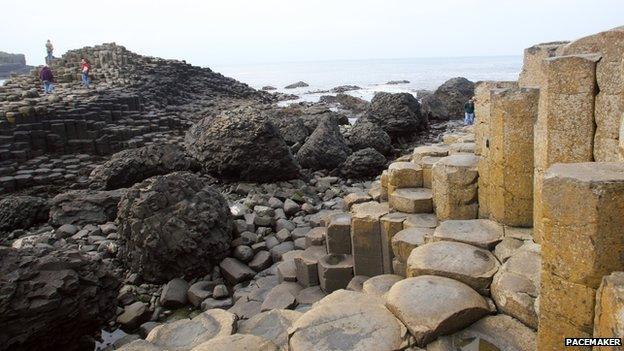Top 100 geological sites: Five NI sites make 'rock star list'
- Published

The Giant's Causeway was the most popular entry from Northern Ireland
Some of Northern Ireland's most popular tourist attractions have made it onto a list of the top 100 geological sites in the UK and Ireland.
They included Northern Ireland's most famous landmark, the Giant's Causeway, and the Marble Arch caves.
The rocky shore of Portrush, County Antrim, and Slieve Gullion mountain, County Armagh, are also on the Geological Society of London's list.
Loughareema, a "disappearing" lake in County Antrim, was also in the top 100.
ckirstinlemon.jpg)
The mystery of the vanishing lake in County Antrim has baffled geologists for years
The list was published to coincide with Earth Science Week and celebrates the UK and Ireland's geological heritage.
The Geological Society described the mysterious body of water at Loughareema as an "ephemeral lake that fills and empties with relative rapidness".
"One day it could be empty, and the next, completely full," the society added.

Loughareema fills and drains regularly, but scientists have been unable to discover the reason why the water disappears
Loughareema, close to the seaside town of Ballycastle, translates from the Irish language as "vanishing lake".
Dr Kirstin Lemon from Geological Survey of Northern Ireland said no-one actually knows why the water drains out of the lake, but this month, scientists are beginning a survey that might help them discover the reason.
She said there are other vanishing lakes in Ireland, because of the amount of limestone on the island.
However, she said as the land around Loughareema is full of impermeable rock known as schist, the disappearing water has "baffled people for years".
Dr Lemon said the presence of chalk in the area might explain the drainage, but hopefully all will be revealed when the project is complete.
Slieve Gullion is a mountain overlooking the Irish border in south Armagh.

The Ring of Gullion is set within an Area of Outstanding Natural Beauty
It is set within the Ring of Gullion, a circle of smaller hills known as a "ring dyke" which was formed by volcanic activity millions of years ago.
It is an area of considerable scientific interest and was first ring dyke in the world to be geologically mapped.
.jpg)
The Ring of Gullion straddles the Irish border
In 1991, the Ring of Gullion was designated by government as an Area of Outstanding Natural Beauty (AONB).
The Marble Arch caves, in County Fermanagh, are a network of underground passages carved by water flowing through limestone.

The Marble Arch caves are among the top tourist attractions in Northern Ireland
The area around the caves has been developed in to a geopark for tourism, conservation, education and research.
The popular seaside resort of Portrush in County Antrim contains a national nature reserve considered to be of significant importance in the development of geology.

Portrush is considered a "place of pilgrimage" for geologists
About 200 years ago, it was the site of a great intellectual battle between two different schools of scientific thought on rock formation.
The Vulcanists believed the rocks in the area were formed by the cooling of molten magma or lava, while the Neptunists incorrectly thought the rocks were a product of an ancient ocean.
Northern Ireland's Environment Minister Mark H Durkan has described the nature reserve as a "place of pilgrimage" for geologists.

The Giant's Causeway is made up of more than 40,000 basalt columns
The Giant's Causeway is Northern Ireland's best known geological gem and has achieved international status as a UNESCO world heritage site.
It is made up of more than 40,000 basalt columns, formed by volcanic activity about 60m years ago.
UNESCO has described it as a "spectacular area of global geological importance".
- Published13 October 2014
